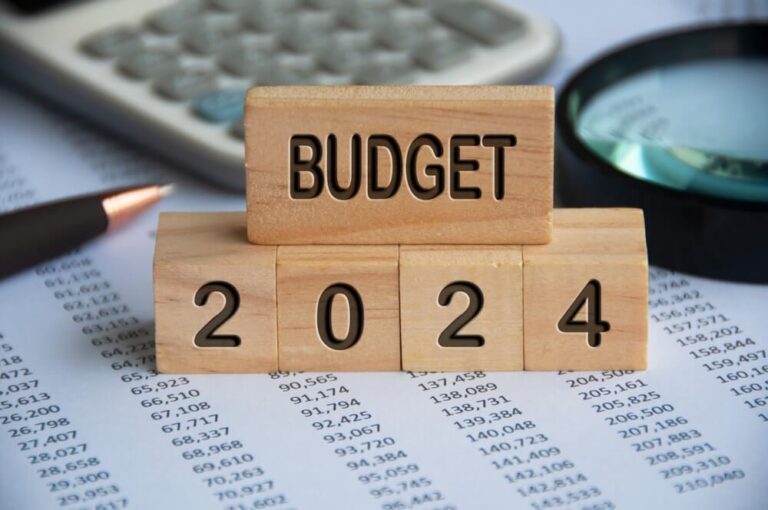Finance Minister Nirmala Sitharaman presented the Union Budget for the seventh consecutive time. She stated that the Budget will focus on employment, skills development, MSMEs, and the middle class. An allocation of ₹1.48 lakh crore was announced for education, employment, and skill development.
Sitharaman announced plans to boost spending, create jobs, and provide relief for the middle class. Extensive job creation is anticipated over the next five years, along with significant changes in tax brackets and rates.
Key tax changes include raising the Securities Transaction Tax (STT), reducing short-term and long-term capital gains taxes, and removing the angel tax. Adjustments to personal income tax slabs in the New Tax Regime were also made.
Budget 2024 Highlights
Key points from the Union Budget presented by Finance Minister Nirmala Sitharaman include the following.
New Tax Slab 2024
The new Tax slabs announced for New Tax Regime are as follows.
- 0 – Rs 3 lakh: Zero tax
- Rs 3 -7 lakh: 5 per cent
- Rs 7-10 lakh: 10 per cent
- Rs 10-12 lakh: 15 per cent
- Rs 12-15 lakh: 20 per cent
- Above Rs 15 lakh: 30 per cent
- Standard Deduction on New Tax Regime increased from Rs 50,000 to Rs 75,000.
Capital Gain taxes
The short-term gains tax on specific financial assets has been increased from 15 percent to 20 percent, while the rates on other financial and non-financial assets remain unchanged.
-
- Long-term gains tax on all assets increased from 10 percent to 12.5 percent.
- The exemption limit on capital gains for certain listed financial assets increased from Rs 1 lakh to Rs 1.25 lakh annually.
- Long-term classification is over one year for listed financial assets, and over two years for unlisted and non-financial assets.
- Unlisted bonds, debentures, debt mutual funds, and market-linked debentures will be subject to the applicable capital gains tax rates, regardless of the holding period.
- The Budget proposed abolishing the ‘angel tax’ for all investor classes to support start-ups and innovation.
- The fiscal deficit for FY25 is projected at 4.9 percent of GDP, down from 5.1 percent in the Interim Budget, with a commitment to reduce it below 4.5 percent next year.
- Expenditure for FY25 is projected at Rs 48.21 trillion.
- Receipts for FY25 are projected at Rs 32.07 trillion.
Customs duty Reductions
- Duties on gold and silver reduced to 6 percent, and on platinum to 6.4 percent.
- Lithium, copper, and cobalt exempted from customs duty.
- Expanded the list of exempted capital goods for solar cell and panel manufacturing.
- Basic customs duty on spandex yarn reduced from 7.5 percent to 5 percent.
- Exempted customs duty on manufacturing connectors and oxygen-fused copper.
Duty cuts on medicines and mobile phones
-
- Customs duty completely exempted on three additional cancer medicines.
- Duty on mobile devices and accessories reduced to 15 percent.
- Increased customs duty on plastic products.
Budget allocations for Andhra Pradesh and Bihar
The budget allocations for Andhra Pradesh and Bihar the following:
- Social and infrastructure funds for Andhra Pradesh, with a grant for three backward districts.
- A package has been announced for the Vizag-Chennai Industrial Corridor.
- Rs 15,000 crore in financial assistance for the development of Amaravati, with promises of future funding.
- Rs 26,000 crore allocated for roads and expressways in Bihar.
- Funds set aside for temple development in Bihar and Odisha.
Other key Budget announcements include the following.
-
- Establishment of 100 new branches of India Post Payments Bank in the North East.
- Creation of twelve new industrial parks.
- Rs 10 trillion allocated to provide 1 crore houses to the urban poor and middle class.
- FM Sitharaman announced a critical mineral mission and the auction of the first offshore mining blocks.
- Introduction of a rental housing scheme for industrial workers under the PPP model.
- Increase in the Mudra loan limit from Rs 10 lakh to Rs 20 lakh for those who have successfully repaid loans under the TARUN category.
- Proposal of three new employment-linked schemes with Rs 2 trillion allocated for job creation over five years, targeting skills development for 20 lakh youth and increasing women’s participation.
- Rs 1.52 trillion allocated for agriculture and allied sectors.
- Release of 109 new high-yielding and climate-resilient varieties of 32 field and cultivation crops for farmers.
- Rs 3 trillion allocation announced for women-centric schemes.




